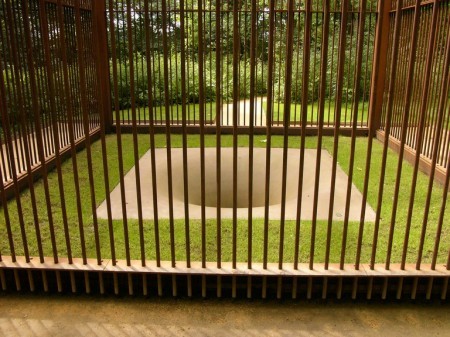Mosaic – Ancient & Modern
October 21, 2015 by Scran | 0 comments
Here’s our second instalment from the Archnetwork Erasmus+ course, Empowering Communities in Cyprus.
Wednesday 16th September 2015. Up early for our road trip we started for the coastal town of Limassol, ready for another day to find out about Cypriot culture.
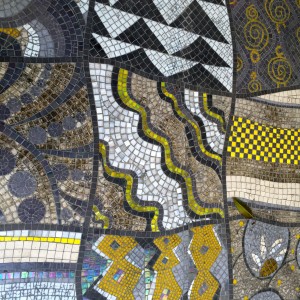 Our first destination was the wonderful Mosaic Collective run by Soula Christou, a truly inspiring woman. The Collective design, create and sell contemporary mosaics across Cyprus and internationally. Their artwork is innovative and work is carried out in both two and three dimensions.
Our first destination was the wonderful Mosaic Collective run by Soula Christou, a truly inspiring woman. The Collective design, create and sell contemporary mosaics across Cyprus and internationally. Their artwork is innovative and work is carried out in both two and three dimensions.
Clients commission the mosaic for domestic settings as well as commercial purposes such as hotels. Soula spoke with passion about her art and with real enthusiasm for life, leaving us all feeling upbeat as we left her studio.
The group had a brief interlude and wandered the narrow streets of old town Lemesos, where we came upon an outlet for the Cyprus Handicraft Service. Part of the Ministry of Energy, Commerce, Industry and Tourism, the Service advocates the preservation of folk art as part of Cypriot cultural heritage and aims to perpetuate folk art as part of Cypriot historical and national identity. What a find! Inside we found a various traditional crafts, including of course Lefkara lace as we had encountered the previous day. However here there was evidence of design innovation, for example one potter had made plates with Lefkara lace imprinted into the surface. The result was simple yet effective, aesthetically pleasing and contemporary. The shop only stocked & sold Cypriot made craft, pricing ranged from affordable to expensive. It’s a shame it is tucked away from the main streets where it would perhaps have more footfall & custom.
We drove out of Limassol, along by Akrotiri. There is a large Royal Air Force station here, so the sky had plenty of military air traffic. Here was another inescapable dimension to Cypriot life, the British military presence.
The afternoon was spent on site, firstly visiting the ancient archaeological site of Kourion. 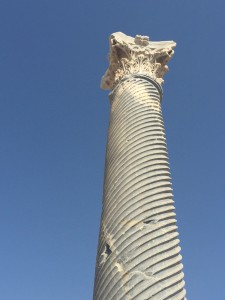 We were able to view staggering Roman mosaics in the House of Achilles, which are protected from the elements under huge canopies. We made direct comparisons with the Mosaic Collective and appreciated the longevity of the medium and it’s ability to tell stories. The whole site was huge and included a cliff top auditorium, classical architectural details littered the area – a brilliant place. I got carried away photographing the ionic capitals in particular. As well as all the perfectly carved stone, the exposed structures of under-floor heating were made from stacked ceramic discs and blocks. Coming from a ceramics trained background, I am always drawn to such functional use of clay, not to mention the Roman drainage system & sewers. We completed our itinerary for the day at The Temple of Hylates.
We were able to view staggering Roman mosaics in the House of Achilles, which are protected from the elements under huge canopies. We made direct comparisons with the Mosaic Collective and appreciated the longevity of the medium and it’s ability to tell stories. The whole site was huge and included a cliff top auditorium, classical architectural details littered the area – a brilliant place. I got carried away photographing the ionic capitals in particular. As well as all the perfectly carved stone, the exposed structures of under-floor heating were made from stacked ceramic discs and blocks. Coming from a ceramics trained background, I am always drawn to such functional use of clay, not to mention the Roman drainage system & sewers. We completed our itinerary for the day at The Temple of Hylates.
Imagery © J.Sangster

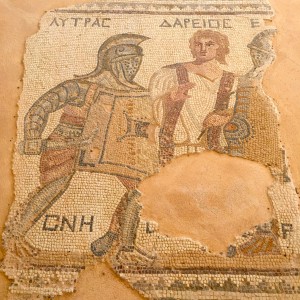
 Tuesday 15th September 2015. Our all-female, party of five had travelled from Scotland. The group consisted of heritage & education professionals with definite interests museum practice, interpretation, learning and community engagement. Although, through the week other interests & skills would surface as we got to know each other.
Tuesday 15th September 2015. Our all-female, party of five had travelled from Scotland. The group consisted of heritage & education professionals with definite interests museum practice, interpretation, learning and community engagement. Although, through the week other interests & skills would surface as we got to know each other.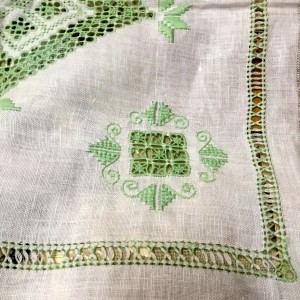 The village & surrounding area is renowned for it’s lace making, so much so, in 2009 it was recognised by UNESCO. Lefkara laces or Lefkaritika was added to the list of the
The village & surrounding area is renowned for it’s lace making, so much so, in 2009 it was recognised by UNESCO. Lefkara laces or Lefkaritika was added to the list of the  Here we were welcomed with some homemade traditional lemonade & shown a wealth of Lefkaritika as well as locally made silver jewellery. I had not seen the lace in reality before and there was no doubt that Lefkaritika was indeed beautiful. The pieces on offer were mostly traditional & could be considered old fashioned by some, however the lace is labour intensive to produce and requires years of skill to become a proficient maker. The lace makers of Lefkara are traditionally women, who learn the art from their mothers & grandmothers. Sadly this knowledge of applying cotton thread to linen is being lost as the population shifts away from Lefkara and other socio-economic pressures increase on Cypriot life.
Here we were welcomed with some homemade traditional lemonade & shown a wealth of Lefkaritika as well as locally made silver jewellery. I had not seen the lace in reality before and there was no doubt that Lefkaritika was indeed beautiful. The pieces on offer were mostly traditional & could be considered old fashioned by some, however the lace is labour intensive to produce and requires years of skill to become a proficient maker. The lace makers of Lefkara are traditionally women, who learn the art from their mothers & grandmothers. Sadly this knowledge of applying cotton thread to linen is being lost as the population shifts away from Lefkara and other socio-economic pressures increase on Cypriot life.
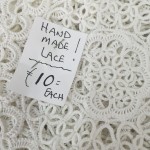
 aware of the power and impact of certain colour schemes. We were informed the homes with blue doors, shutters & window frames, were those of Greek Cypriots whereas the homes with green paintwork, were those of Turkish Cypriots, some of which were unoccupied. In the same vein, many doors had knockers in the shape of a woman’s hand. These would be referred to as the hand of Mary or the hand of Fatima depending on whether it was a Greek Cypriot Christian or Turkish Cypriot Muslim home respectively. Amongst the numerous Greek Orthodox churches in Lefkara we visited the impressive & ornate 14th Century Timios Stavros church. Further down the hill we also admired the derelict, but well maintained, mosque. It quickly became apparent to me that impact of history, politics and conflict was visible everywhere. As a visitor it was plain to see Lefkara is one village, with two distinct communities linked through many common threads.
aware of the power and impact of certain colour schemes. We were informed the homes with blue doors, shutters & window frames, were those of Greek Cypriots whereas the homes with green paintwork, were those of Turkish Cypriots, some of which were unoccupied. In the same vein, many doors had knockers in the shape of a woman’s hand. These would be referred to as the hand of Mary or the hand of Fatima depending on whether it was a Greek Cypriot Christian or Turkish Cypriot Muslim home respectively. Amongst the numerous Greek Orthodox churches in Lefkara we visited the impressive & ornate 14th Century Timios Stavros church. Further down the hill we also admired the derelict, but well maintained, mosque. It quickly became apparent to me that impact of history, politics and conflict was visible everywhere. As a visitor it was plain to see Lefkara is one village, with two distinct communities linked through many common threads.
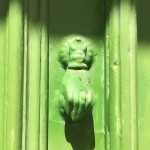


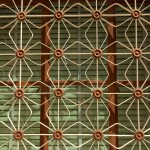

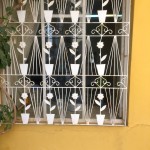


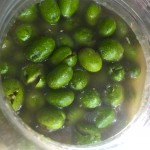 Our evening meal was prepared for us by our second host, Panayiota Demetriou local resident of the neighbouring village of Kato Drys. We observed the lighting of the customary Cyprus outdoor oven, a selection of dishes including tavas was put in & the domed oven was then sealed with clay for several hours of slow cooking. The results were delicious & served us well as a welcoming feast.
Our evening meal was prepared for us by our second host, Panayiota Demetriou local resident of the neighbouring village of Kato Drys. We observed the lighting of the customary Cyprus outdoor oven, a selection of dishes including tavas was put in & the domed oven was then sealed with clay for several hours of slow cooking. The results were delicious & served us well as a welcoming feast.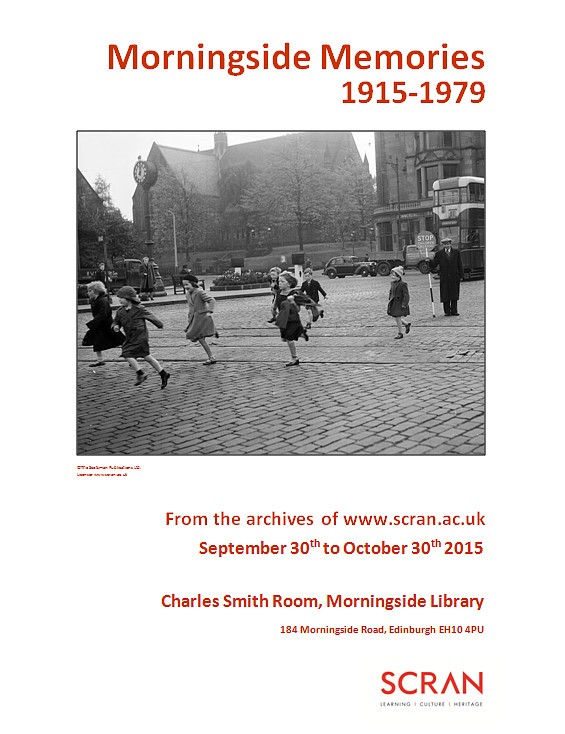 The staff at the library kindly allowed us to use their Charles Smith Room, located upstairs at the branch and usually filled by exhibitions by local artists. In it, we’ve hung 19 prints of Scran images of the local area from the archives of the National Museums of Scotland, The Scotsman and RCAHMS. These date from 1915 to 1979, and depict a bygone age when trams were still drawn by horses, kindly lollipop men helped children across busy junctions and Morningside Station was still a regular stop on the Edinburgh Suburban line. We worked with
The staff at the library kindly allowed us to use their Charles Smith Room, located upstairs at the branch and usually filled by exhibitions by local artists. In it, we’ve hung 19 prints of Scran images of the local area from the archives of the National Museums of Scotland, The Scotsman and RCAHMS. These date from 1915 to 1979, and depict a bygone age when trams were still drawn by horses, kindly lollipop men helped children across busy junctions and Morningside Station was still a regular stop on the Edinburgh Suburban line. We worked with 

